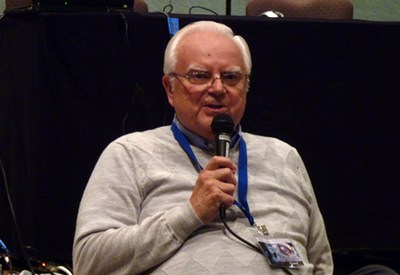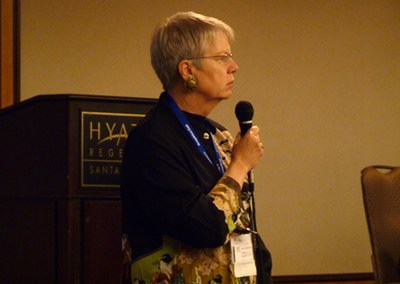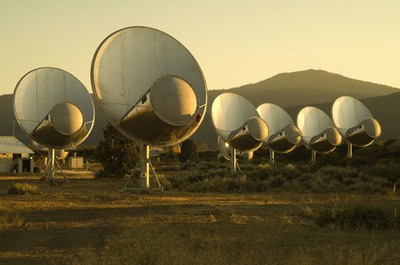SETI at 50by Jeff Foust
|
| “In the 1950s it was considered a very dangerous thing for a scientist to embark on anything to do with life in space,” Drake recalled. |
SETI researchers and their supporters, though, have managed to carry on despite the institutional obstacles and lack of success. Earlier this month several hundred people, from scientists to enthusiasts, came to Santa Clara, California, for the first SETICon, a weekend conference organized by the SETI Institute to honor SETI’s 50th anniversary, as well as the 80th birthday of Drake and the institute’s own 25th anniversary. The conference—which had more of the flavor of a science fiction “con” than a traditional scientific conference—was an opportunity to reflect on SETI’s past while also chart a course for future efforts to answer that fundamental question: are we alone?
SETI’s humble origins
That initial SETI survey 50 years ago, called Project Ozma, took place at a time when mainstream science had turned away from the idea of life in space. “In the 1950s it was considered a very dangerous thing for a scientist to embark on anything to do with life in space,” Drake recalled in one session. “It was considered a flaky subject that only people who couldn’t do legitimate science might do.”
Drake said he got support for carrying out Project Ozma from the director of the new National Radio Astronomy Observatory (NRAO), the eminent astronomer Otto Struve, who was one of the few scientists of the era not disinclined to the subject of extraterrestrial life. “It so happened that Struve himself was very interested in life in space,” Drake said. “He didn’t have to defend himself against the taboo; he was too great a man.”
Drake said he approached Struve, noting that larger radio telescopes and advances in detector technology allowed them to detect signals from nearby stars of comparable strength of what Earth was transmitting. Struve was interested, and allowed the project to proceed on two conditions: that it not cost a lot, and that it would have utility for ordinary radio astronomy. Drake complied by developing a detector that operated at the 21-centimeter line of hydrogen, which had considerable scientific applications, and cost $2,000, “not an amount that would offend anybody.”
The first two stars targeted by the project were Tau Ceti and Epsilon Eridani. Tau Ceti didn’t yield anything, but when then turned to Epsilon Eridani, “within a minute we suddenly heard out of the loudspeaker this huge sound, one that we had never heard before.” Drake said it was a pulsing sound, repeating at about ten times a second. “Was it that easy?” he wondered about detecting was appeared to be an artificial signal on almost their first try. The signal went away, though, before they could complete tests to see if the signal was, in fact, coming from that star.
Drake said they tried to keep the detection quiet until they could do follow up observations, but word nonetheless leaked out. “Sure enough, by the next morning the phone was ringing off the hook,” he said. Eventually, he said, the signal came back. This time it was detected by both the main radio telescope and a separate omnidirectional telescope, which meant that it was terrestrial in origin, not a signal from a civilization on Epsilon Eridani. “We never really knew what the source of this was,” he said, although it did have the characteristics of a military radar jammer.
 Frank Drake talks about the early history of SETI during a session at the SETIcon conference. (credit: J. Foust) |
Are we searching the right way?
In the 50 years since Project Ozma, the vast majority of SETI searchers have focused on radio transmissions. The technology and the telescopes have improved, but other than a small amount of work in optical SETI—looking for laser pulses deliberately transmitted towards us—SETI continues to remain focused on radio wavelengths. But is this the best approach?
| “The number of people in the world actively involved in SETI could fit into a phone booth,” said Tarter. |
A lot of approaches have been suggested over the years, from gravity waves to neutrinos, said Seth Shostak, senior astronomer at the SETI Institute. Many, though, appear infeasible or too expensive from an energy standpoint to be worthwhile. There are, though, other, simpler searches that are possible: one possibility he suggested was looking for stars with an excess of infrared emission—evidence, perhaps, of waste heat from astroengineering projects.
An analogous approach suggested by Drake is to look for stars with spectral lines created by compounds that don’t exist in nature. One example he suggested was chlorofluorocarbons, as they are artificially produced and create strong spectral lines even in trace amounts. It was something that even our civilization could do relatively easily: 100 tons of Freon dumped into the Sun would be enough to create discernable spectral lines, Drake estimated. (“Of course, the EPA would be climbing the walls,” he joked.)
That “one-bit” signal wouldn’t at first seem particularly useful, given the ability to encode much more information into a radio signal, but Shostak said it would serve as something of a beacon. “The assumption is that there’s something more interesting to be found now that you’re going to be spending a lot of time looking at that spot in the sky,” he said.
And, while a half-century of radio searches have turned up empty, there’s a lot more that can be wrung out of the radio part of the electromagnetic spectrum. That’s the direction the SETI Institute is going with its Allen Telescope Array, an array of 42 small dishes (eventually planned to go to 350) located in northern California. “It’s really turning this into a computational problem,” said Greg Papadopoulos, former CTO of Sun Microsystems and a member of the institute’s board of trustees. “Let’s look for progressively more complex signals.”
SETI goes open source
The challenge with increasingly complex SETI search techniques is that the resources and expertise of the SETI community is fairly limited. “The number of people in the world actively involved in SETI could fit into a phone booth,” said Jill Tarter, director of the Center for SETI Research at the SETI Institute.
Without access to additional funding, Tarter and others are turning to another approach to increase the size and expertise of the field: the open source model best known for developing the Linux operating system and thousands of other applications widely used today. At SETICon Tarter announced a new project, called setiQuest, designed to open up the code and algorithms used by SETI to the public, in the hopes that people will use and build upon them, providing a new source of innovation for SETI efforts.
The setiQuest effort will be providing access to existing code and algorithms (posted on GitHub, a site that hosts a wide range of open source coding projects), cloud computing resources for developing new algorithms, and even raw data sets. The hope is to attract both people interested in SETI as well as those who may not be interested in the concept but are looking for specific routines, such as in digital signal processing, who would use the SETI code in their own projects, make improvements, and submit that changed code for potential use in SETI projects.
| Any dismissal of SETI as a failure “reflects the lack of understanding of the magnitude of the search,” added Vakoch. “It’s very plausible that it may take decades for traditional passive SETI searches to succeed.” |
The project is just getting started, and Tarter and others said they are still trying to determine the best way to run this effort. (A closed-door meeting during SETICon was devoted to working on issues of governance and organization for setiQuest.) She and others are looking to other open source software projects for lessons and best practices; one topic of discussion is whether the project needs a single overarching leader, or “benevolent despot”, such as Linux had in its early development with its founder, Linus Torvalds, personally accepting or rejecting additions to the code developed by others.
SetiQuest is following a similar path as another project, SETI@home, which starting in 1999 has allowed the public to get involved by helping process data sets for SETI projects. However, Tarter and others emphasized that setiQuest would be more participatory that SETI@home, which is primarily a distributed computing project. SETI@home, she said, was “fantastic”, but “that’s not an arena that you can actually change. We want to set up a community where your creativity can in fact lead to capabilities.”
“SETI@home uses your resources to do computing,” said Avinash Agrawal, director of innovation at the SETI Institute. “We are giving you resources to allow us to extend what we do.”
 Jill Tarter describes the new setiQuest open source project at the SETIcon conference. (credit: J. Foust) |
Should we talk back?
Another topic of discussion and debate revolves around what is often called “active SETI”: deliberately sending out transmissions to other stars to let any civilizations there that might be listening of our existence. Earlier this year in a Discovery Channel documentary Stephen Hawking warned that such communication was ill-advised, fearing the worst of any direct contact with an alien civilization that might arise if we let them know we exist: “If aliens ever visit us, I think the outcome would be much as when Christopher Columbus first landed in America, which didn’t turn out very well for the Native Americans.”
John Billingham, a retired NASA scientist who led SETI programs there in the early 1990s, endorsed Hawking’s caution about broadcasting our presence. “No one can say that there’s no risk to transmitting,” he said in a statement read at the conference. He endorsed the concept of a global conference to discuss the merits and concerns of such transmissions, perhaps leading to a treaty to determine who should transmit such messages and their contents.
Others, though, noted that we have been broadcasting, as radio broadcasts and other emissions that have “leaked” out from Earth over the decades that could be easily detected by an extraterrestrial civilization. “This horse has left the barn,” Shostak said. “Any society that could possibly be a threat to us can easily know that we’re here.”
Shostak and others also took issue with the claim that such civilizations, alerted to our presence, would go after us for our resources. “To me it is almost inconceivable that there is a material resource worth traveling light-years to collect,” said science fiction writer Robert J. Sawyer. “The energy required to collect it will almost always be more expensive than the cost of making it at home.”
An advanced civilization would likely have to get any warlike instincts under control if it is to survive, added social scientist Douglas Vakoch. And even if they didn’t, “can they do us any harm at interstellar distances?”
So where are they?
The fact remains, though, that 50 years of SETI searches have failed to turn up any evidence yet that there are other civilizations out there—at least any we can detect with our current technologies and methodologies. Does that mean that there’s no one out there at all, no one out there bothering to communicate, or that we haven’t given the search enough time yet?
| “This notion that we need someone to talk to may very well be an adolescent notion,” said Sawyer. |
Most at SETICon gravitated towards the last explanation. “We still have only scratched the surface of a multidimensional search space of SETI,” Billingham said in his statement. Any dismissal of SETI as a failure “reflects the lack of understanding of the magnitude of the search,” added Vakoch. “It’s very plausible that it may take decades for traditional passive SETI searches to succeed.”
Others, though, argued that other civilizations simply might not be interested in communicating with others. “Is in fact the most dangerous thing to the long-term survival of a race individuality?” asked Sawyer. Civilizations that do survive may need to sacrifice individuality in order to avoid threats to their survival like terrorism, and are thus less interested in communicating with others. “This notion that we need someone to talk to may very well be an adolescent notion.”
Drake, the father of modern SETI, remains positive about not just the prospects of finding a signal from another civilization but the impact it will have on our own. “The impact of this will be great for every person on Earth in the long run,” he said. Any civilization we detect, he argued, will likely be far more advanced than our own, and thus we would have much to learn from them; he described the “wonderful turmoil” of information that could come from such a signal.
“I’m always an optimist,” Drake said. Optimism—and persistence—may be the critical elements of the next 50 years of SETI.
